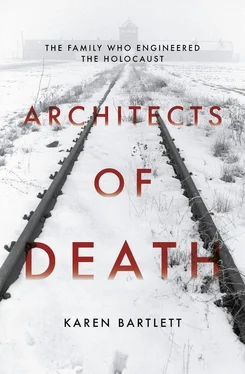This golden era for Topf and Sons reflected a spirit of natural optimism, urban vigour and nationhood that had emerged more widely in Germany. An ‘optimism about mechanical civilisation, pride in German culture, the importance of mobilising civic energies and belief in social and moral improvement’ [8] Ibid.
went hand in hand with a second industrial revolution focused on chemicals, electronics, precision instruments and optics. Germany was now a world leader in technology, philosophy, law, medicine, biology, chemistry and physics. It was a revolution driven by a growing class of salaried workers who went to work in modern offices every day, like those in the administration building at Topf and Sons, and who spent their wages on better food and drink.
Then, on 15 February 1914, Ludwig Sr committed suicide. It was a shocking end to a seemingly successful life. In one generation, he had taken his company from shaky beginnings to an established international business, and had cemented his own role as an Erfurt civic leader. Local newspapers proclaimed that he was the epitome of the ‘city’s industrial magnates’, yet at the age of fifty-one he had taken his own life while suffering from ‘nervous exhaustion’ at a sanatorium in the Harz Mountains. Like his father before him, it appeared that the strain of running Topf and Sons had proved too much for him, and he had long talked about selling off one of the company’s two divisions. Although the company remained on a sound commercial footing, Ludwig Sr left behind a wife and three young children, who were fractured by his death and the sudden change in their family life. Both his sons would mythologise his memory, while trying, and often failing, to live up to his legacy.
In the aftermath of his death, control of the company passed to Ludwig’s widow Else Topf with the expectation that it would then eventually be handed on to the Topf sons. The unfolding of tortured family relationships between Else Topf and her children, and the rise of other powerful forces within the company, would make this far from certain, however.
Unwittingly, Ludwig had chosen to commit suicide only a few months before the outbreak of First World War – an event which would fundamentally transform the nature of both his country and his company. During the war itself, Topf and Sons expanded its areas of production to include war vehicles and grenades. After the war, the Treaty of Versailles demanded that Germany pay huge reparations to France and Europe via its coal supplies (some local German currency at the time showed enormous coal trains snaking across Germany, heading for Paris) – forcing German industry to turn from coal to lignite. The ever innovative Topf and Sons responded to this by developing lignite furnaces, expanding their chimney construction business, and then, from 1925, producing ventilation systems.
The year of Ludwig’s suicide would become a significant one for Topf and Sons for another reason, too – it was also the year that the company began producing furnaces for crematoria. Rising urban populations in the nineteenth century and concerns about hygiene and lack of space in graveyards had given rise to a new European movement in favour of human cremation.
Despite religious objections and a ban by the Catholic Church that remained until 1963, a social movement, ‘the cremationists’, sprang up in Germany to advocate a more modern and technologically advanced way of disposing of human remains. Although cremation had long been practiced in other parts of the world, it was an idea that required a huge shift in European culture, essentially away from Christianity and the belief in life after death and resurrection.
The debate about the nature of cremation, and the rules it must adhere to, still shape the practice today. For example, before cremation can take place the body must be examined by two people to ensure that the person is dead, and that they have not been killed by unnatural means. Furthermore, the European Cremation Congress of Dresden in 1876 ruled that cremation should be carried out quickly and be completely odourless in furnaces used exclusively by humans. A person should be cremated alone, and their ashes collected together. Two years later, German crematoria had taken this reverence for the human body a stage further, opening a Crematorium In Gotha that used super-heated air – meaning that the body never came into contact with the fire. The Siemens-Schneider regenerative furnace was pre-heated with coke for four hours to reach a temperature of 1000°C. After that it was forbidden to add any further fuel, and the cremation itself took place solely in the hot air and gasses that surrounded the body.
The years of the Weimar Republic, and its emphasis on secular modernism, saw an enormous increase in cremation rather than burial – with the number rising from 630 cremations in five crematoria in 1900 to more than 50,000 in 103 different crematoria in 1930. Such prospects for a profitable industry meant that not all companies agreed with the stringent requirements for human cremation. Notably, Heinrich Kori from Berlin opposed the ‘sacred cow’ of human cremation in favour of his already commercially successful methods for animal incineration. He opposed the Prussian Cremation Act of 1911 and argued in favour of replacing cremation by hot air in favour of burning bodies using direct burning gasses. When Kori and Topf went head to head in competition to supply the crematorium at Arnstadt in 1924, Kori’s ‘furnaces for wastes of all kinds’ lost out to Topf because of Kori’s disregard for the human reverence regulations.
Topf and Sons complied with the spirit, as well as the letter of the law, meaning that by the mid-1920s they were national and international leaders in supplying technologically advanced cremation solutions. Not only did they support the regulations surrounding ‘reverence’, they created ingenious solutions to make human cremation even more dignified. Under the supervision of engineer Kurt Prüfer, who ran the furnace construction department at Topf and Sons, the company developed what was known as a ‘muffle’ – a slider between the coke generator and oven chamber that meant the oven could be sealed before the coffin was in place. The company introduced the first gas-heated oven in 1927, followed by the first electric oven in 1933.
Prüfer was not only responsible for innovative designs, he was also the figurehead of the company’s innovation in this area, promoting the work of Topf and Sons to the wider industry and crematoria movement. He kept abreast of debates about cremation, and was a member of the Erfurt People’s Cremation Society. In 1931 he wrote to Flame magazine, published by the Berlin cremation society, explaining why Topf avoided the methods used by Hamburg designers Volkmann and Ludwig in which a gas pipe was directly placed near parts of a human body that were more difficult to incinerate, blowing compressed air directly over the body. Within the company, he clearly distinguished between his work for human cremation ovens, calling them ‘cremation systems’ and other animal and waste incinerators, which he termed ‘elimination ovens’. These distinctions would later prove crucial in evaluating the role Topf and Sons played in the Holocaust.
When Ludwig Sr’s sons, Ludwig and Ernst Wolfgang, took control of Topf and Sons in the early 1930s they inherited a company that was established as an international leader in the malting industry, with a small but technologically advanced sideline in cremation technology. Their inheritance, however, came about only as a result of a bitter court battle they waged against their own mother and the other Topf and Sons company directors.
After the death of their father in 1914, Ludwig and Ernst Wolfgang endured a peripatetic and patchy upbringing. Their mother gave up the family home, and sent both sons away to boarding school in the Thuringian town of Gumperda. Although the brothers were close, the differences between them became apparent even at an early age. By the time the boys took their Reifeprufung , the equivalent of a high school diploma or leaving certificate, it seems Ludwig was already falling behind. Although he was a year older than his brother Ernst Wolfgang, the boys took their examination together, indicating that Ludwig had already taken a break from education. Indeed, it was Ludwig Topf who became the first of his siblings to fall out with his mother, when, upon leaving schoool, she refused to give him any more financial support.
Читать дальше












